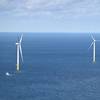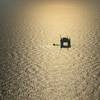Air Ride Craft, Inc., Miami, has developed a new marine vehicle that promises to revolutionize the fast-craft industry. The Seacoaster combines the best features of the Surface Effect Ship (SES) and the catamaran. The vessel is the subject of extensive ongoing patent efforts both in the U.S. and internationally. It is applicable to all manner of marine craft markets including commercial and military.
Noted benefits compared to monohulls and catamarans are Seacoaster:
· Requires only 60 percent of the power and fuel at cruise speeds;
· Provides good ride qualities in rough seas at all headings.;
· Has low wake at cruise speeds; and
· Offers pricing comparable to other craft due to its simple low cost design.
The first of these new vessels will go into service on Lake Erie this summer as a 44 knot, 150-passenger ferry for Island Express Boat Lines Ltd., Sandusky, Ohio. The passenger ferry, called Island Rocket II, is depicted in an artist's drawing in Figure 1. The 72 ft. vessel is shown, less its passenger cabin, while underway during seatrials, in Figures 2 and 3. Its arrangement drawings are presented in Figure 4.
All SESs, including Seacoatser, run in surface effect mode on the water surface. They have a blower pressurized air cushion entrapped between their hull and the water surface. When moving forward at high speeds, this pressurized air cushion is at the sea level water surface at the bow. The water is depressed by the force of the cushion pressure moving over it so the transom is lower than the bow. The result is a pressurized air cushion moving with the SES and carries some 75 to 90 percent of its weight. This, in turn, results in significantly reduced wetted area hull friction than other hull forms. As a result, the SES normally requires only half the propulsive power of monohulls or catamarans at speeds of 25-30 knots or more.
The most well known generic forms of the SES both have flexible seals. The first, commonly known as "hovercraft" or Ground Effect Machines (GEM), was successfully developed by an Englishman, Christopher Cockerel, in the late fifties. The vessels feature flexible skirts all around and are truly amphibious. While efficient from a propulsion standpoint, these amphibious SESs require about as much blower power as propulsive power since there is a high volume of air leakage under their full periphery flexible skirts. Several 180-ft. hovercraft have been in operation running between England and France since the sixties.
A non-amphibious variation of the hovercraft with flexible seals fore and aft only and solid hull structure water contacting sidewalls was first tested by the U.S. Navy in the mid-sixties. This development, subsequently becoming the first vessel type named the Surface Effect Ship (SES), led to much interest and commitment in both the U.S. and overseas. It only required about 15 percent of power to run the blower(s) and was inherently more stable, due to its hard structure sidewalls, than the full skirted hovercraft. The U.S. Navy funded two 100-ton SES test craft in the early seventies. One of these SES's demonstrated speeds in the 100 mph area.
There have been numerous other SES development efforts, both private and government funded, over the years; however, many have been marred by higher running costs and rough sides.
Seacoaster's inventor, Don Burg, patented, designed, and had built several fixed hard hull structure monohull SESs, ranging up to a 65 ft. crewboat, in the late seventies and early eighties. He was also involved in the design and patenting of some 110 ft. flexible bow seal SES passenger ferries in the mid eighties. While all of these vessels operated well and were efficient, they were not optimum craft.
Based on the accumulated prior design and operational experience, the inventor took a radical new approach to SES design in the late eighties. The result is the new Seacoaster, which incorporates the best features of the SES and the catamaran. The first U.S. patent on the revolutionary new Seacoaster invention was filed by the inventor in 1991 and issued in 1993.
Based on the excellent results from the model tests, a group of private investors provided the initial funding to start a 48 ft. test and demonstration Seacoaster in 1995. The Department of Energy (DOE) had a thorough review of the Seacoaster invention conducted in 1995 and 1996 by the National Institute of Standards and Technology (NIST), Office of Technology Innovation and their consultant, Stephen Philips, director of Seaspeed Technology Limited of Hampshire, U.K.
Based on excellent reports by both recommending the Seacoaster invention, it was given a top rating as an energy saving invention. As a result, the DOE made a grant as a top rated energy saving invention to the Seacoaster program through its Energy Related Inventions Program (ERIP) in 1996.
The project was expanded and the boat stretched to its present 65 ft. length over main deck and 72 ft. length overall when support from industry leaders was made available in 1997. This included two Caterpillar 3406E marine diesel propulsor engines and a Caterpillar 3116 marine diesel blower engine from Pantropic Power Products, Inc., Miami, and two Twin Disc 5114 gearboxes and two Arneson ASD12 surface propeller drives from Twin Disc Inc., Racine, Wis.
Figure 6 presents the machinery arrangements of the boat, showing the propuslor engines and drives and the blower machinery arrangements. Note that the single blower engine drives port and starboard sidehull blowers through a right angle gearbox. Air comes into the aluminum and stainless steel blowers through large stainless steel air silencers that are in turn connected to round openings in the sides of the hull forward.
The boat was first run in March of 1998 as an open demonstrator. A number of enhancements were made to the hull in 1998. These enhancements resulted in the boat meeting its design performance criteria in December 1998. It has demonstrated speeds of 44 knots at 30 long tons or 67,000 lbs on a continual basis.
Engine power during those tests was 675 hp to each propeller and 150 hp to the blowers. This totals 1,500 hp. Total fuel consumption, including the blower engine, at 44 knots was 78 gph which compares to a total fuel consumption for the standard catamaran of approximately 130 gph.
A slight reduction in Seacoaster propulsor engine power levels results in a significant reduction in fuel consumption. For example, at its as-tested 30 long tons displacement and a cruise speed of 38 knots, the fuel consumption is only 50 gph due to lower propulsor engine power requirements. That means with a total fuel tankage of 1,200 gallons it has a range of approximately 834 nautical miles. Factoring in a 25 percent power increase to account for rough water operation still gives a range of 625 nautical miles.
The Seacoaster hull has exceptional ride qualities in rough water. Tests conducted for the Office of Naval Research (ONR) in early February, 1999, showed g force readings to be 0.4g (RMS) as measured on a forward mounted accelerometer and 0.2g (RMS) as measured on an aft mounted accelerometer when running at approximately 30 knots into five to six ft. head seas.
These are exceptionally low values and are attributed to the fact there is little hard hull structure on the underside of the bow forward that can be impacted by waves. Any waves simply ride up into the air cushion recess and do not have impacts with hard hull structure.
The Seacoaster hull also proved itself to be extremely stable when at rest or traveling at low speeds in heavy seas. Tests conducted with all engines shut down and lying abeam to six to seven ft. seas showed a stable platform with little movement. This extreme stability characteristic of Seacoaster is invaluable when applied to sportfishing boats, patrol boats, and the like that spend long periods of time on station or traveling at low speeds.
The wake signature of Seacoaster is extremely low. This is because the hull rides high in the water since it is largely supported by its pressurized air cushions. While no exact wake measurements have been made to date, comments by several naval architects, boat operators, etc. were that they have not seen such a low wake on any similar size and displacement vessel of other designs.
The first Seacoaster was directed toward the high speed passenger ferry market mainly because that market is most receptive to new advanced technology. The first Seacoaster ferry, rated for 150 passengers, is being refitted with larger Caterpillar 3412 diesels rated at 1,015 hp, replacing the initially installed Caterpillar 3406E diesels commercially rated at 675 hp. This engine upgrade was done to account for the heavier displacement brought on by addition of the passenger cabin and pilothouse, larger tankages, insulation and fire fighting and other equipment necessary to meet USCG requirements.
Larger passenger and passenger/vehicle ferry Seacoaster designs, up to 328 ft. and larger, are underway. Figure 8 shows a model of a 175 ft. 55-60 knot Seacoaster ferry. That ferry can transport 600 passengers comfortably in very heavy seas. One of its possible applications is on a run from Miami to Havana once relations with Cuba allow such an operation. Since less expensive lower power engines can be used, the cost of Seacoaster ferries are equal to or less than comparable ferries of other designs, which operate at lower speeds.
Seacoaster is also designed for application to high-speed patrol boats and other military craft. Preliminary design work related to 54 ft. and 110 ft. 50-70 knot Seacoaster patrol boats has been completed.
Designs of larger high speed Seacoaster military craft have also been started. One such example is a 330 x 106 ft. trans-oceanic combatant. That combatant can reportedly achieve 60-70 knots with a pair of General Electric LM2500 30,000 hp marine gas turbines.
Subscribe for
Maritime Reporter E-News
Maritime Reporter E-News is the maritime industry's largest circulation and most authoritative ENews Service, delivered to your Email five times per week










